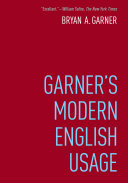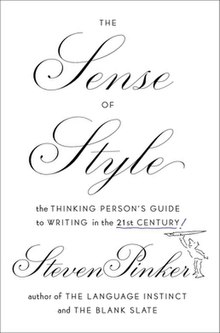In linguistics, the grammar of a natural language is its set of structural rules on speakers' or writers' usage and creation of clauses, phrases, and words. The term can also refer to the study of such rules, a subject that includes phonology, morphology, and syntax, together with phonetics, semantics, and pragmatics. There are, broadly speaking, two different ways to study grammar: traditional grammar and theoretical grammar.
Punctuation marks are marks indicating how a piece of written text should be read and, consequently, understood. The oldest known examples of punctuation marks were found in the Mesha Stele from the 9th century BC, consisting of points between the words and horizontal strokes between sections. The alphabet-based writing began with no spaces, no capitalization, no vowels, and with only a few punctuation marks, as it was mostly aimed at recording business transactions. Only with the Greek playwrights did the ends of sentences begin to be marked to help actors know when to make a pause during performances. Punctuation includes space between words and the other, historically or currently used, signs.
Singular they, along with its inflected or derivative forms, them, their, theirs, and themselves, is a gender-neutral third-person pronoun. It typically occurs with an indeterminate antecedent, in sentences such as:
In English writing, quotation marks or inverted commas, also known informally as quotes, talking marks, speech marks, quote marks, quotemarks or speechmarks, are punctuation marks placed on either side of a word or phrase in order to identify it as a quotation, direct speech or a literal title or name. Quotation marks may be used to indicate that the meaning of the word or phrase they surround should be taken to be different from that typically associated with it, and are often used in this way to express irony. They are also sometimes used to emphasise a word or phrase, although this is usually considered incorrect.

Linguistic prescription, or prescriptive grammar, is the establishment of rules defining preferred usage of language. These rules may address such linguistic aspects as spelling, pronunciation, vocabulary, syntax, and semantics. Sometimes informed by linguistic purism, such normative practices often suggest that some usages are incorrect, inconsistent, illogical, lack communicative effect, or are of low aesthetic value, even in cases where such usage is more common than the prescribed usage. They may also include judgments on socially proper and politically correct language use.

The Associated Press Stylebook, alternatively titled The Associated Press Stylebook and Briefing on Media Law, is a style and usage guide for American English grammar created by American journalists working for or connected with the Associated Press journalism cooperative based in New York City. The Stylebook offers a basic reference to American English grammar, punctuation, and principles of reporting, including many definitions and rules for usage as well as styles for capitalization, abbreviation, spelling, and numerals.
The usage of a language is the ways in which its written and spoken variations are routinely employed by its speakers; that is, it refers to "the collective habits of a language's native speakers", as opposed to idealized models of how a language works or in the abstract. For instance, Fowler characterized usage as "the way in which a word or phrase is normally and correctly used" and as the "points of grammar, syntax, style, and the choice of words." In everyday usage, language is used differently, depending on the situation and individual. Individual language users can shape language structures and language usage based on their community.

In the English language, there are grammatical constructions that many native speakers use unquestioningly yet certain writers call incorrect. Differences of usage or opinion may stem from differences between formal and informal speech and other matters of register, differences among dialects, and so forth. Disputes may arise when style guides disagree with each other, or when a guideline or judgement is confronted by large amounts of conflicting evidence or has its rationale challenged.
"Between you and I" is an English phrase that has drawn considerable interest from linguists, grammarians, and stylists. It is commonly used by style guides as a convenient label for a construction where the nominative/subjective form of pronouns is used for two pronouns joined by and in circumstances where the accusative/oblique case would be used for a single pronoun, typically following a preposition, but also as the object of a transitive verb. One frequently cited use of the phrase occurs in Shakespeare's The Merchant of Venice (1596–98). According to many style guides, the Shakespearian character who used the phrase should have written "between you and me". Use of this common construction has been described as "a grammatical error of unsurpassable grossness", although whether it is in fact an error is a matter of debate.
In English-language punctuation, a serial comma is a comma placed immediately after the penultimate term in a series of three or more terms. For example, a list of three countries might be punctuated as either "France, Italy and Spain" or "France, Italy, and Spain".
In written English usage, a comma splice or comma fault is the use of a comma to join two independent clauses. For example:
It is nearly half past five, we cannot reach town before dark.
Scare quotes are quotation marks that writers place around a word or phrase to signal that they are using it in an ironic, referential, or otherwise non-standard sense. they may imply skepticism or disagreement, belief that the words are misused, or that the writer intends a meaning opposite to the words enclosed in quotes. Whether quotation marks are considered scare quotes depends on context because scare quotes are not visually different from actual quotations. The use of scare quotes is sometimes discouraged in formal or academic writing.
In linguistics, a redundancy is information that is expressed more than once in linguistics.
Sentence spacing concerns how spaces are inserted between sentences in typeset text and is a matter of typographical convention. Since the introduction of movable-type printing in Europe, various sentence spacing conventions have been used in languages with a Latin alphabet. These include a normal word space, a single enlarged space, and two full spaces.
In literature, writing style is the manner of expressing thought in language characteristic of an individual, period, school, or nation. As Bryan Ray notes, however, style is a broader concern, one that can describe "readers' relationships with, texts, the grammatical choices writers make, the importance of adhering to norms in certain contexts and deviating from them in others, the expression of social identity, and the emotional effects of particular devices on audiences." Thus, style is a term that may refer, at one and the same time, to singular aspects of an individual's writing habits or a particular document and to aspects that go well-beyond the individual writer. Beyond the essential elements of spelling, grammar, and punctuation, writing style is the choice of words, sentence structure, and paragraph structure, used to convey the meaning effectively. The former are referred to as rules, elements, essentials, mechanics, or handbook; the latter are referred to as style, or rhetoric. The rules are about what a writer does; style is about how the writer does it. While following the rules drawn from established English usage, a writer has great flexibility in how to express a concept. Some have suggested that the point of writing style is to:

Garner's Modern English Usage (GMEU), written by Bryan A. Garner and published by Oxford University Press, is a usage dictionary and style guide for contemporary Modern English. It was first published in 1998 as A Dictionary of Modern American Usage, with a focus on American English, which it retained for the next two editions as Garner's Modern American Usage (GMAU). It was expanded to cover English more broadly in the 2016 fourth edition, under the present title. The work covers issues of usage, pronunciation, and style, from distinctions among commonly confused words and phrases to notes on how to prevent verbosity and obscurity. In addition, it contains essays about the English language. An abridged version of the first edition was also published as The Oxford Dictionary of American Usage and Style in 2000 and a similar version was published in The Chicago Manual of Style 16th edition in 2017. The latter includes three sections titled "Grammar", "Syntax" and "Word Usage", each with several subcategories.
The dash is a punctuation mark consisting of a long horizontal line. It is similar in appearance to the hyphen but is longer and sometimes higher from the baseline. The most common versions are the en dash–, generally longer than the hyphen but shorter than the minus sign; the em dash—, longer than either the en dash or the minus sign; and the horizontal bar―, whose length varies across typefaces but tends to be between those of the en and em dashes.
Sentence spacing guidance is provided in many language and style guides. The majority of style guides that use a Latin-derived alphabet as a language base now prescribe or recommend the use of a single space after the concluding punctuation of a sentence.
Officialese, bureaucratese, or governmentese is language that sounds official. It is the "language of officialdom". Officialese is characterized by a preference for wordy, long sentences; complex words, code words, or buzzwords over simple, traditional ones; vagueness over directness; and passive over active voice. The history of officialese can be traced to the history of officialdom, as far back as the eldest human civilizations and their surviving official writings.
Comprised of is an expression in English that means "composed of". This is thought by language purists to be improper because to "comprise" can already mean to "be composed of", and by that definition, "comprised of" would be ungrammatical. However, another widely accepted definition of to "comprise" is to "compose", hence the commonly accepted meaning of "comprised of" as "composed of".




